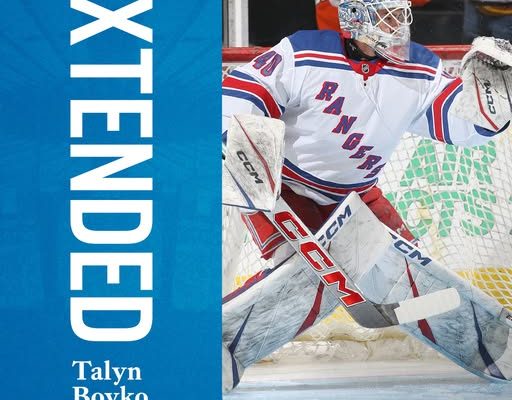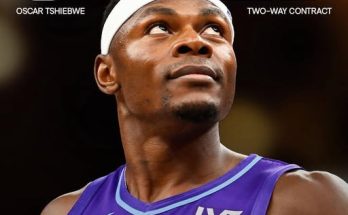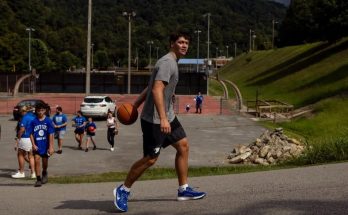The New York Rangers and goaltender Talyn Boyko have agreed to terms on a one-year contract extension, a move that both strengthens the team’s organizational depth and offers the young netminder another chance to prove himself within one of hockey’s most storied franchises. In the grand scheme of the Rangers’ offseason maneuvers, this deal may appear modest compared to splashy signings or blockbuster trades, but it represents something much more significant in terms of development strategy, player evaluation, and the delicate balance NHL teams must maintain between established stars and future contributors. Boyko, a tall, athletic goaltender who has spent recent years working to refine his game at the professional level, now finds himself with another opportunity to continue his progression in the Rangers’ system, a chance he and the organization hope will yield dividends down the line.
For the Rangers, extending Boyko reflects both practicality and foresight. Goaltending depth has always been a priority for teams aspiring to contend, and while Igor Shesterkin holds the starting job and remains one of the best goaltenders in the world, NHL seasons are long and filled with unexpected challenges. Injuries, performance fluctuations, and the sheer physical demand of an 82-game schedule plus playoffs make it essential for franchises to cultivate multiple options in net. Shesterkin’s dominance has masked some of these concerns in recent years, but the Rangers know that depth behind him is just as important. A one-year extension for Boyko ensures they keep a promising young goaltender within the fold while continuing to evaluate his potential and readiness for bigger opportunities.
Boyko’s career to this point has been defined by his size, raw ability, and the developmental patience required of goaltenders. Standing at six-foot-seven, he is an imposing presence in the crease, a frame that naturally covers much of the net and can make shooters second-guess their angles. Scouts have long been intrigued by his physical tools, but as with most young goaltenders, the challenge has been translating natural gifts into consistent, high-level performance. The Rangers, like many NHL organizations, recognize that goaltending is perhaps the most unpredictable position to project, with many netminders taking years before they find their footing in professional hockey. By retaining Boyko for another season, the team signals its belief that he is worth the continued investment of time and resources.
From Boyko’s perspective, this deal is both validation and opportunity. Validation in the sense that the Rangers see enough promise in his development to keep him within the system rather than cutting ties, and opportunity because a one-year contract is essentially an open audition. He will need to continue showing progress, whether in the AHL with the Hartford Wolf Pack or, if necessary, in the ECHL, where he has logged meaningful minutes in recent seasons. Every practice, every game, and every stretch of consistency matters at this stage of his career. A strong season could lead to another extension or even elevate him into consideration as a legitimate NHL backup option. A poor showing, on the other hand, could signal the end of his tenure with the Rangers. The stakes, while not front-page headlines, are quietly enormous for a player in Boyko’s situation.
One of the reasons this extension makes sense for both sides is the timeline of the Rangers’ goaltending picture. With Shesterkin entering his prime and the team’s competitive window firmly open, the organization is under pressure to maximize its chances of winning now. Yet they also need to prepare for the long term. A franchise cannot afford to simply ride one elite goaltender without considering injury risks or potential declines. Behind Shesterkin, the Rangers have cycled through backup options, but there has not been a long-term, homegrown solution cemented in the role. Boyko may not be ready to fill that void yet, but his development keeps the door open. Even if he never becomes a full-time NHL starter, he could evolve into a dependable backup or a valuable piece of organizational depth, roles that are often underestimated until they are desperately needed.
The financial aspect of this extension also works seamlessly for the Rangers. A one-year deal for a developing goaltender carries little risk and plenty of upside. The salary cap implications are minimal, and in today’s NHL, where cap management is a delicate puzzle, cost-effective contracts for depth players are a necessity. For the Rangers, this deal essentially buys them another year to evaluate Boyko without committing significant financial resources. For Boyko, the structure provides clarity—he knows exactly what the next year holds, and he can focus solely on improving his game without worrying about immediate contract negotiations or instability.
Boyko’s journey illustrates the broader challenges and realities of developing goaltenders in professional hockey. Drafted in the later rounds, he entered the Rangers’ system as a project player, someone whose ceiling was tantalizing but whose path was uncertain. Unlike skaters, who often make more linear progressions through junior leagues and into professional roles, goalies frequently face uneven trajectories. Confidence, mental toughness, and adaptability to higher levels of competition are all as critical as physical ability. Boyko has already faced ups and downs, spending time bouncing between leagues, but each stop has offered lessons and opportunities for growth. The Rangers’ willingness to extend him indicates that they have seen enough signs of progress to warrant further investment, even if the path ahead remains uncertain.
There is also a symbolic element to deals like this one. For the organization, retaining players like Boyko sends a message to the entire prospect pool that development is valued and patience is part of the process. For teammates, it reinforces that hard work and perseverance can lead to continued opportunities, even if stardom does not come overnight. For fans, while the signing may not generate the same buzz as a blockbuster trade, it is a reminder of the layers of preparation required to build a sustainable contender. Championships are rarely won by star players alone; depth, resilience, and internal development are equally crucial. Boyko’s extension fits into that framework as one of the many small, deliberate steps a franchise must take to remain competitive year after year.
The upcoming season will be pivotal for Boyko. He enters it with the backing of the organization but also with heightened expectations. He will need to demonstrate improved consistency, sharpen his technical skills, and continue to adapt to the speed and precision of professional shooters. Goaltenders of his size often face unique challenges, such as refining lateral movement and rebound control, areas that can turn natural advantages into liabilities if not properly managed. Coaches and development staff will be watching closely to see if Boyko can translate his physical gifts into reliable performance. Every game in the AHL or ECHL is a chance to prove he is trending in the right direction, and every strong stretch could earn him more trust from the organization.
For the Rangers, the timing of this deal also aligns with their broader organizational objectives. As they push to compete in a loaded Eastern Conference, they need every aspect of their roster and developmental system functioning smoothly. A stable goaltending pipeline is part of that equation. With Shesterkin in place as the present and Boyko extended as part of the future, the Rangers are covering both bases. While fans and analysts will focus heavily on marquee players and immediate playoff aspirations, deals like this are the subtle reinforcements that help keep teams competitive over time.
In the larger picture, Boyko’s story underscores the unpredictability and allure of goaltending prospects. For every highly touted goaltender who fails to pan out, there are late bloomers who defy expectations. The Rangers have experienced this firsthand, most notably with Henrik Lundqvist, a seventh-round pick who became a franchise legend. While it would be unfair to place such lofty comparisons on Boyko, his extension represents the same philosophy: never overlook potential, and never stop nurturing talent, no matter how uncertain the trajectory may seem.
The one-year contract extension between the New York Rangers and Talyn Boyko is not a headline-grabbing blockbuster, but it is a meaningful decision rooted in smart roster management, developmental patience, and organizational foresight. For Boyko, it is a lifeline and a challenge rolled into one—a chance to prove that his size, skill, and perseverance can add up to a lasting NHL career. For the Rangers, it is a low-risk, high-upside move that keeps their goaltending pipeline intact while providing flexibility for the future. As the next season unfolds, all eyes may not be on Boyko, but his journey will quietly continue to play a role in shaping the Rangers’ long-term success. And in the world of professional hockey, where championships are built on both stars and depth, such moves often matter more than they first appear.



